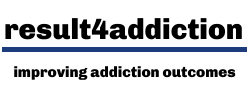How good is alcohol treatment?
Treatments for addiction problems have much in common regardless of the substance. Many people believe that cutting down on drinking is the way forward. Sometimes this works but often it does not. For people with their heart set on this goal, it is okay to ‘give it a go’ with the proviso that if it doesn’t work then aim for an abstinence goal.
① Stabilisation ② Relapse prevention ③ Lifestyle change ④ Harm reduction
Stabilisation
Abstinence (detoxification)
Stopping drinking is the fastest and probably best way to stabilise. Some people will experience withdrawal symptoms such as shakiness, sweating, feeling tired and irritable, which start after 6-8 hours and diminish over 2-3 days; for people with severe addiction there is a risk of having a fit, highest on the 2nd to 3rd day, and of hallucinating (alcoholic delirium), sometimes called the DTs, on the 3rd to 4th days.
If withdrawal symptoms are severe then a medically assisted detoxification is the safe option. Prescribers will be familiar with guidelines for detoxification. Chlordiazepoxide (Librium™) is the best medication for reducing withdrawal symptoms - diazepam (Valium™) is an alternative but it is more addictive. Lorazepam (Ativan™) is best if there is a history of fits or hallucinations on withdrawal.
Cutting down
Cutting down is usually more difficult for a problem drinker than simply stopping. Both cutting down and controlled drinking (best guided by a psychologist) have conditions, all of which should be met.
Nalmefene (Selincro™) is marketed as a medication to help heavy drinkers reduce their consumption. It is designed to reduce the pleasant effects of drinking. It is recommended not to be used for dependent drinkers as a means of stabilisation.
On average alcohol is metabolised (broken down) by 1 unit per hour by both men and women. There is a lot of individual variation because of differences in the liver enzymes that metabolise alcohol.
Checklist for cutting down…
✔︎ low level of alcohol dependence (Leeds Dependence Questionnaire)
✔︎ to be in daily contact with a supportive person
✔︎ agree no-drinking rules (abstinence in high risk situations)
✔︎ no significant alcohol related health problems
✔︎ an ability to control impulsivity
Relapse prevention
The availability and legal status of alcohol make it difficult to avoid and difficult for people dependent on alcohol to abstain or moderate its use. What might trigger drinking?
in the short term
withdrawal symptoms that previously cued drinking
feeling well again a couple of days after detoxification
forgetting that alcohol is omnipresent
in the long term
personal high risk situations
Rating high risk situations is the first task in a relapse prevention programme. Once identified and rated for the degree of temptation and the individual’s belief in their coping ability, new coping strategies can be identified, practised and implemented in real life. Guidance on implementing a relapse prevention intervention can be found in the iSBNT manual page30.
Relapse prevention medication...
▷ Acamprosate (Campral™️) mimics some of the effects of alcohol in the brain and it is claimed thereby reduces craving. There are no negative effects from drinking on top of acamprosate | not very effective
▷ Naltrexone (Nalorex™) blunts the pleasurable effects of drinking and thereby makes continued drinking less likely. The main pharmacological effects only happen during periods of drinking | good for high risk situations
▷ Disulfiram (Antabuse™) takes away the desire to drink because drinking on top of disulfiram causes an unpleasant, potentially dangerous reaction (sweating, heart pounding, nausea) | effective for abstinence goal
Lifestyle change
It is feasible to get on with the challenge of lifestyle change, which may include sorting out mental health issues, once a person has some control of their drinking. Brief treatments, 2-3 sessions, can be as effective as longer treatments for people who have lower levels of dependence and more social capital. Social treatments are most likely to be effective, not just for problem drinkers but also for their family and friends; other approaches can be effective provided that they are well structured and well delivered. Guidance on addressing lifestyle change can be found in the iSBNT manual page 41. The recovery tasks are all about making lifestyle changes.
Harm reduction
Generic harm reduction measures to improve health and wellbeing are to be applied throughout treatment. Heavy drinkers may have nutritional deficiencies, notably Thiamin (Vitamin B1). This can cause serious brain damage and taking high dose supplements is important. Multi-vitamins may, in addition, be helpful. Read about dealing with vitamin deficiency. Take a look at the Harm and Harm Reduction slides on the How do drugs work? page.



